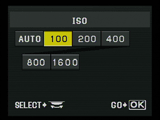Olympus E-410
-
-
Written by Gordon Laing
Olympus E-410 sensor and files
More Features : Lenses and viewfinder / Screen and menus / Sensor and processing / Anti dust / Anti shake
Olympus E-410 features continued…
Lenses and viewfinder / Screen and menus / Sensor and processing / Anti dust / Anti shake
The Olympus E-410 is equipped with a brand new 10 Megapixel N-MOS sensor developed by Matsushita; as the parent company of Panasonic, it’s fair to surmise we’ll be seeing this sensor in at least one forthcoming Panasonic DSLR. Olympus has also confirmed the E-410’s sensor is the same as that in the E-510, so this report can act as a preview of the next model’s potential image quality.
Conforming to the Four Thirds standard, the sensor measures 17.3x13mm, delivers 4:3 aspect ratio images and effectively reduces the field-of-view of all lenses by two times; so the optionally-bundled Zuiko Digital 14-42mm ED lens delivers coverage equivalent to 28-84mm.
 |
 |
Sensitivity is offered from 100 to 1600 ISO, but unlike the E-400, this is now only offered in single EV increments. The E-410 also offers a number of noise reduction options: a Noise Filter can be set to Off, Low, Standard or High, while Noise Reduction using dark-frame subtraction can be enabled or disabled. By default the E-410 is set to its Standard Noise Filter and with Noise Reduction On, and these are the settings we’ve used for our Coverage, Gallery and Outdoor Resolution tests. We’ve included examples with the other Noise Filter settings on our Outdoor Noise results page.
Olympus E-410 image quality settings
 | |
The E-410’s sensor may use a different technology to its predecessor, thereby allowing Live View facilities, but the resolution and image quality settings remain the same. The E-410’s maximum image size measures 3648×2736 pixels which at 300 dpi is good for reproduction at around 12x9in.
When set to the highest resolution, you have the choice of two different JPEG compression ratios, along with an option to record a RAW file in the Olympus ORF format with or without an accompanying JPEG. The E-410’s RAW files are different from the E-400’s, so you’ll need an update for any third-party software. At the time of writing, the E-410’s RAW files weren’t supported by Adobe Camera RAW, but Olympus supplies a copy of its Master software for basic conversions.
Like other Olympus cameras, the best quality SHQ JPEG mode employs a very mild compression ratio of just 1 / 2.7 which essentially eliminates any compression artefacts, albeit with fairly hefty files sizes as a result – you’re looking at around 5.5-7.5MB for each SHQ JPEG, although with today’s large memory cards we still welcome this option. RAW files are also more manageable on the E-410: its predecessor’s uncompressed RAW files typically measured 21MB each, compared to around 10MB each on the E-410.
Olympus E-410 colour and white balance
 |
The E-410 features a wide range of White Balance options. Along with Auto, custom and one-touch white balances, the E-410 offers separate daylight, shade, cloudy, incandescent and three fluorescent presets. You can even fine-tune the Red and Green levels of each preset with a Live Preview if desired.
 |
 |
Contrast, sharpness and saturation are applied using a choice of three Picture Modes, along with an additional Monotone option. In the Vivid, Natural and Muted colour Picture Modes, Contrast, Sharpness and Saturation can all be adjusted on a scale of -2 to +2. In the Monotone mode you can apply colour effects including a sepia tone, or simulate the use of colour filters including yellow, orange, red and green.
Interestingly while the first E-400s set their Vivid mode by default, Olympus released a firmware update which changed the default mode to Natural. Here on the E-410 though, Olympus has once again defaulted to Vivid mode and as such we’ve used it for all our test and gallery shots. It’ll be interesting to see if this is changed with a future update, although we were perfectly happy with the results in the Vivid mode which delivered punchy, consumer-friendly JPEGs from the camera.
Olympus E-410 continuous shooting
Olympus claims a continuous shooting rate of 3fps with up to six frames in RAW mode. To put this to the test we fitted the E-400 with a 1GB SanDisk Ultra II Compact Flash memory card, set the shutter speed to 1/1000 and selected the continuous drive mode.
 | |
We fired-off ten SHQ JPEGs in three seconds or seven RAW files in 2.3 seconds before the camera momentarily paused for breath; this confirms the 3fps shooting rate and frame buffer.
In terms of startup, the E-410 performs a compulsory anti-dust process every time you power it up – this means the E-410 is ready for action about one second after first switching it on. This sounds much slower than the typical 0.2 second startup times of rival DSLRs when written down, but in practice it doesn’t feel slow and won’t affect many people. While we like cameras which are ready for action quickly, we’d sooner sacrifice half a second or so at startup if it saves us minutes (or even hours) retouching dust from images later. To find out how the E-410 performs in terms of anti-dust, see our next Features page.




